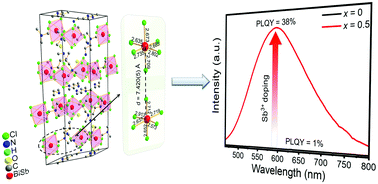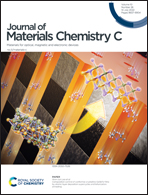Antimony and bismuth cooperation to enhance the broad yellow photoluminescence of zero-dimensional hybrid halide†
Abstract
As an emerging material, organic–inorganic metal halides (OIMHs) have been widely studied in the field of optoelectronics in recent years. In this work, a series of compounds (TMEDA)3(SbxBi1−x)2Cl12·H2O (0.1 ≤ x ≤ 0.6) (TMEDA = N,N,N′-trimethylethylenediamine) were synthesized. The incorporation of Sb3+ greatly enhanced the photoluminescence quantum yield of (TMEDA)3Bi2Cl12·H2O from 1% to 38%. The variation in the degree of distortion of the inorganic octahedra and the relatively suitable distances between metal ions are considered to be the reasons for the intense emission. (TMEDA)3(SbxBi1−x)2Cl12·H2O (0.1 ≤ x ≤ 0.6) exhibited a yellow phosphorescence emission at 605 nm and 595 nm under excitation at 305 nm and 375 nm, respectively. With the incorporation of Sb3+, changes in the emission intensity under different excitation wavelengths showed different trends. Thus, we attribute the yellow broadband emissions to the triplet emission of Bi3+ and Sb3+. Finally, we combined (TMEDA)3(Sb0.5Bi0.5)2Cl12·H2O with commercial phosphors and a near-ultraviolet light-emitting diode chip to prepare a white-light-emitting diode device, which exhibited a high color-rendering index of 94.4. The aim of our work was to investigate the structural effects of the photoluminescence of Sb3+-doped OIMHs and to further explore ways to improve the Sb3+ emission efficiency in the field of photoluminescence of OIMHs.



 Please wait while we load your content...
Please wait while we load your content...